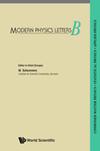Aspects of chemical reaction and mixed convection in ternary hybrid nanofluid with Marangoni convection and heat source
IF 1.8
4区 物理与天体物理
Q3 PHYSICS, APPLIED
引用次数: 0
Abstract
The proposed study examines the effect of inclined magnetic field on a ternary hybrid nanofluid flow that is axisymmetric thermo-solutal Marangoni convective over an infinite disc. Some well-known uses of Marangoni convection include semiconductor production, atomic reactors, crystal growth, fine art mechanisms, melting, thin-film stretching and welding processes. The non-uniform heat generation and viscous dissipation are taken into account. The thermal conductivity and diffusivity coefficient are presumed to vary inversely with linear function of temperature and concentration. The ternary hybrid nanofluid, which consists of silicon dioxide ([Formula: see text]), iron oxide ([Formula: see text]), molybdenum disulfide ([Formula: see text]) and ethylene glycol as base liquid, undergoes an energy transition to improve heat transfer. The system of PDEs is transformed into nonlinear ordinary differential equations (ODEs) by using the appropriate transformations. Using the BVP4C method, this problem is numerically solved. The heat and mass phenomena rates on flow behavior are investigated using tables and graphs to address the impact of several physical and flow parameters on velocity, concentration, and thermal profiles. By increasing the Marangoni convection parameter, the surface tension gradient gets stronger, leading to more efficient heat and mass transfer inside the liquid as well as stronger induced flows. As the temperature and concentration profiles decrease, the outcome is a more consistent dispersion of these properties throughout the liquid.带有马兰戈尼对流和热源的三元混合纳米流体中的化学反应和混合对流问题
本研究探讨了倾斜磁场对三元混合纳米流体流动的影响,这种流动是在无限圆盘上的轴对称热固性马兰戈尼对流。马兰戈尼对流的一些众所周知的用途包括半导体生产、原子反应堆、晶体生长、美术机制、熔化、薄膜拉伸和焊接过程。非均匀发热和粘性耗散已被考虑在内。假定导热系数和扩散系数与温度和浓度的线性函数成反比变化。三元混合纳米流体由二氧化硅([式:见正文])、氧化铁([式:见正文])、二硫化钼([式:见正文])和作为基液的乙二醇组成,通过能量转换来改善传热。通过适当的变换,将 PDE 系统转换为非线性常微分方程(ODE)。使用 BVP4C 方法对该问题进行了数值求解。利用表格和图表研究了热和质量现象率对流动行为的影响,以解决几个物理和流动参数对速度、浓度和热剖面的影响。通过增加马兰戈尼对流参数,表面张力梯度变得更强,从而导致液体内部更有效的热量和质量传递以及更强的诱导流。随着温度和浓度剖面的减小,这些特性在整个液体中的分散也会更加一致。
本文章由计算机程序翻译,如有差异,请以英文原文为准。
求助全文
约1分钟内获得全文
求助全文
来源期刊

Modern Physics Letters B
物理-物理:凝聚态物理
CiteScore
3.70
自引率
10.50%
发文量
235
审稿时长
5.9 months
期刊介绍:
MPLB opens a channel for the fast circulation of important and useful research findings in Condensed Matter Physics, Statistical Physics, as well as Atomic, Molecular and Optical Physics. A strong emphasis is placed on topics of current interest, such as cold atoms and molecules, new topological materials and phases, and novel low-dimensional materials. The journal also contains a Brief Reviews section with the purpose of publishing short reports on the latest experimental findings and urgent new theoretical developments.
 求助内容:
求助内容: 应助结果提醒方式:
应助结果提醒方式:


